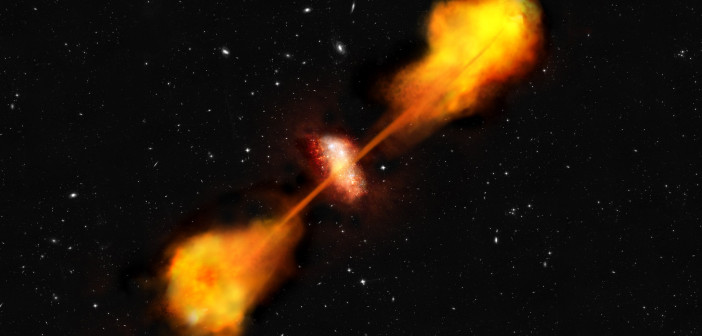Most radio galaxies exhibit a single pair of radio lobes marking the endpoints of their jets. But the unusual three pairs of radio lobes of a recently observed radio galaxy may reveal information about this galaxy’s past.
![A 610 MHz image displaying J1216+0709’s three sets of radio lobes: inner, middle, and outer. These were likely caused by three different episodes of AGN activity. [Adapted from Singh et al. 2016]](https://aasnova.org/wp-content/uploads/2016/08/fig26-260x163.jpg)
A 610 MHz image displaying J1216+0709’s three sets of radio lobes: inner, middle, and outer. These were likely caused by three different episodes of AGN activity. [Adapted from Singh et al. 2016]
Core-Jet-Lobe
Radio galaxies, a subclass of active galactic nuclei (AGN), typically exhibit what’s known as a “core-jet-lobe” structure. A supermassive black hole accreting matter at the galaxy’s core flings material out at the poles, forming two symmetric jets of highly energetic particles. These jets can travel vast distances before spreading out into giant, radio-emitting lobes.
Thousands of these double-lobed radio galaxies have been observed, but a few dozen are unique cases that exhibit two pairs of lobes. These different pairs likely formed during two different phases of AGN activity: the jets were activated long enough to inflate the first lobes, then turned off, and then turned back on again and inflated the second lobes.
Now, the third-ever case of a triple set of lobes has been discovered: the radio galaxy J1216+0709, located roughly 2 billion light-years away.
Clues from Morphology
![A spectral image map between the 325 and 620 MHz GMRT observations. There’s no signature of compact hot-spot structures in the outer lobes, indicating that the supply of jet material to the outer lobes stopped long ago. [Adapted from Singh et al. 2016]](https://aasnova.org/wp-content/uploads/2016/08/fig35-260x208.jpg)
A spectral image map between the 325 and 620 MHz GMRT observations. There’s no signature of compact hot-spot structures in the outer lobes, indicating that the supply of jet material to the outer lobes stopped long ago. [Adapted from Singh et al. 2016]
The radio lobes detected in J1216+0709 consist of an inner pair ~310 thousand light-years across, a nearly coaxial middle pair ~770 thousand light-years across, and an outer pair ~2.7 million light-years across. Singh and collaborators note several important observations about the galaxy’s morphology:
- The outer pair of lobes is much fainter than the inner pairs, and it doesn’t contain any hot spots. This makes sense if the outer lobes are the oldest, as expected, and are no longer being actively fed.
- The inner pairs of lobes are both brighter and longer on their eastern sides than on their western sides, suggesting that the jets are intrinsically asymmetric.
- The outer pair of lobes is bent with respect to the inner jets. This could mean that the material is interacting with the surrounding environment, which may have a large-scale density gradient. Alternatively, it could mean that the galaxy moved in between the two cycles of AGN activity.
Interaction as a Trigger
What could be triggering the bursts of jet activity? Singh and collaborators reference J1216+0709 against a catalog of galaxies and clusters, and find that the host galaxy is part of a small group of three galaxies.
Though there’s no visible disturbance in the host galaxy’s morphology, minor interactions with two nearby dwarf galaxies could be triggering the sporadic AGN activity. In the future, more sensitive optical data may be able to confirm this model.
Citation
Veeresh Singh et al 2016 ApJ 826 132. doi:10.3847/0004-637X/826/2/132


1 Comment
Pingback: jets tell history of radio galaxies